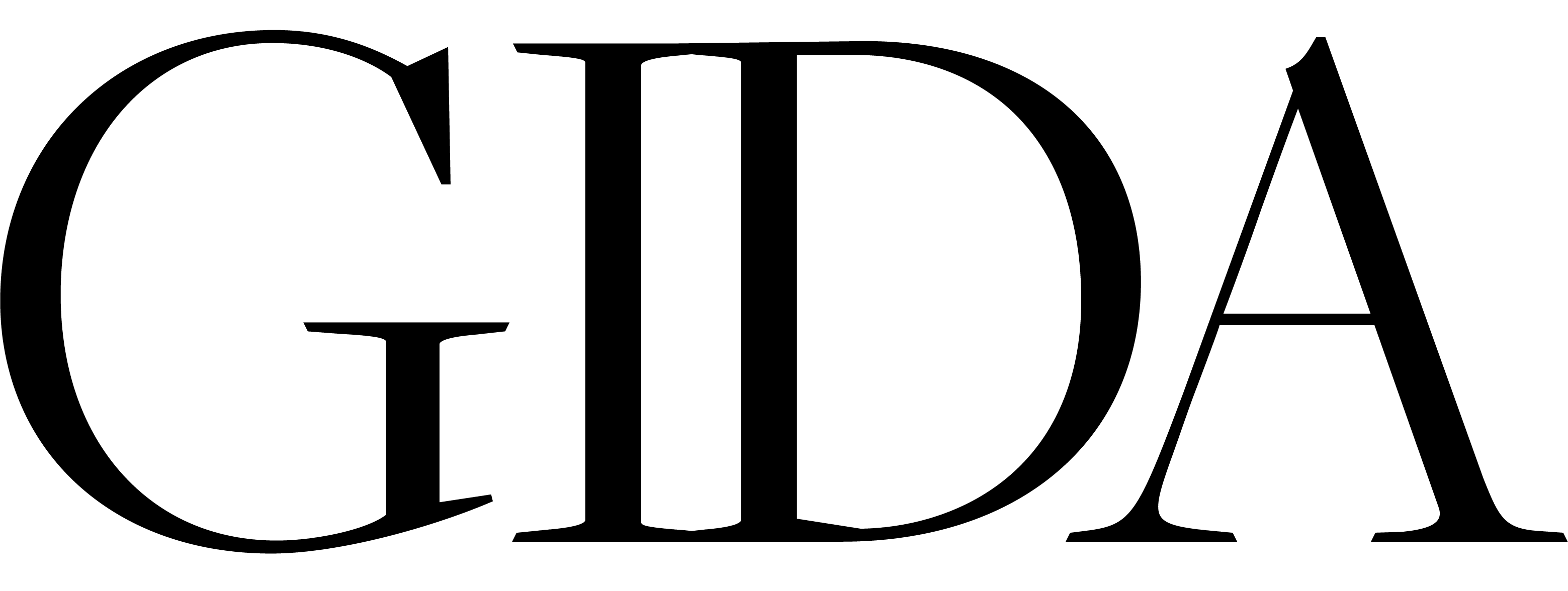
Reframing Heritage:
Sara Benabdallah at 1-54
Interview by Mira Makadia
Photography by Adberrahmane Ajja
February 2024 | GIDA x 1-54 MEDIA PARTNERSHIP
MARRAKECH/LONDON After navigating through the labyrinthine streets of the medina, we arrived at the doorstep of Moroccan filmmaker and visual artist Sara Benabdallah’s studio. The space was vast and open, characterised by symmetrical arches and pristine white plastered walls. Mosaic tiled the floor, and bright light poured through the ceiling-wide skylight overhead. The shift from the chaos outside to the cool serenity of Sara’s studio felt like a collective exhale - a moment for our nervous systems to regulate.
Immersing ourselves in Sara’s world was effortless, with the intentional details that made up the space guiding our conversations. From the framed first map of Marrakech to a pair of playful chairs, crafted by Sara, that defined the reading area, each element offered insight into Sara’s creative process and the inspirations behind her multi-disciplinary practice. It was evident that Sara’s contemporary visions of Moroccan identity and womanhood are deeply rooted in an unwavering appreciation, understanding, and endless curiosity about her country’s cultural heritage. Back in London, our conversation continued, delving into the intricacies of her latest work, Al-Astrulabiya, the joys and challenges of collaborative practice, and the importance of engaging young people with their history.
Sara Benabdallah unveiled her latest work, Al-Astrulabiya, earlier this month at La Mamounia with Nil Gallery, as part of the Marrakech 1-54 Contemporary African Art Fair.
Mira: The Egyptian architect Hassan Fathy once said, ‘It is hoped that before it is too late Near Eastern architects will come to realise the intrinsic value of their architectural heritage. In doing so, they will reap the rich rewards of the accumulated experience that was left to them by their ancestors and will produce successful and enduring works of art.’ 1 Across Africa, traditional craft and the intergenerational knowledge held by artisans are under acute threat. How has Moroccan cultural heritage, architecture, and craftsmanship informed your development as an artist?
Sara: I was born and raised in the medina, but due to my parents, I didn’t have the traditional upbringing of many around me. They were ahead of the game in the 1980s and 1990s because they saw the potential in Moroccan traditional homes when others were abandoning them as they were just too expensive to maintain, but also, many just didn’t see the value in them. It’s part of colonisation - you have a whole continent that’s so beautiful and rich, but we’re enamoured by European things. My father visited over 5000 riads in Marrakech, so naturally, he knows the whole city by heart. In my childhood, he would buy one home to renovate, and we would live in it. It was our home, but also the construction site, the office, the studio, so I was born and grew up around craftsmen.
When I came back to Morocco after nearly a decade in America, I started working with my dad and realised that he has continued working with the same artisans from my childhood. To create the copper frames in my current work, Al-Astrulabiya, presented at 1-54 Contemporary African Art Fair in Marrakech last month, I too worked with these same artisans. The younger generation in Morocco is not interested in these crafts, and there has been a huge decline in work and knowledge. I knew that exhibiting at La Mamounia for 1-54 would come with exposure on social media and press, so it was an opportunity to connect with them. I made those big-ass frames by hand with their intricate details and imperfections to showcase the heritage we’re losing.
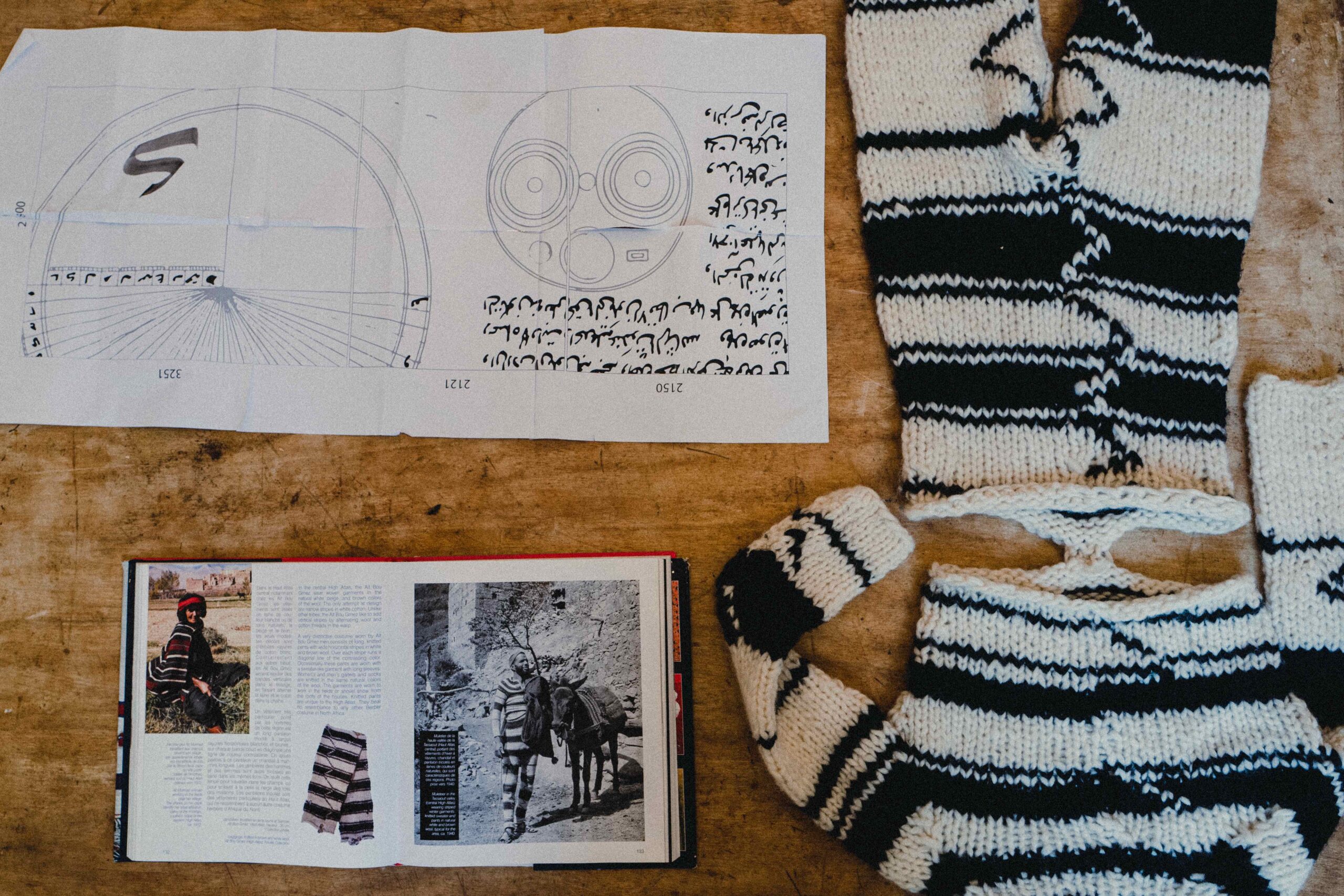
Mira: I found it very touching when I learned that you have maintained this intergenerational relationship with the craftsmen from your childhood. Your practice is an exercise in knowledge-sharing between your collaborators, yourself, and your audience, so I’m interested to hear more about how you approach that process with the craftsmen. What does collaboration look like in practice?
Sara: Collaboration was not always easy. Artisans in Morocco have their own way of working, their own way of life. They have their systems, their traditions; for example they don’t work on Fridays. The process is very slow, and everything is handmade, so it’s ten times more difficult to produce. For Al-Astrulabiya, I approached them with the idea of the astrolabe, and I thought perhaps they wouldn’t be familiar with the instrument, but they knew exactly what I was talking about.
Astrolabes were made in Marrakech, all the way from the 8th to 13th centuries. The people in the medina, the craftsmen, are aware of that history, and that is the kind of knowledge I want to bring to young people. I want to bridge that disconnect between generations through my work. It was important for me to give my craftsman collaborators creative freedom, and that decision allowed them to teach me, and I was able to learn a lot from them. It was a collaboration, not a commission. We had difficulties, and we found solutions together. It was a challenging but beautiful experience.
Mira: Your work offers us new ways to articulate identity that embrace duality and aren’t rooted in fixed ideas of belonging. In your latest work, Al-Astrulabiya, you use the symbolism of the astrolabe, an instrument of celestial observation, as a way of interrogating exchange between Western and Islamic worlds. How did this idea develop for you?
Sara: The idea slowly built up to the astrolabe. It was my first exhibit, so I discovered a lot about myself, specifically that I’m very drawn to the sky and to astronomy. I knew this work would have to be created outside and connected to the sky, the sky ratios. I started with the wooden frames, and the first detail that stood out to me was a star called Ain Mamma, again drawing me back to the themes of astronomy. Eventually, I stumbled upon the astrolabe - an instrument I was familiar with but didn’t know a lot about. My grandfather used to collect them, and I’ve seen them before in the medina, but through researching, I learnt that although the astrolabe was created in Ancient Greece, it was developed and refined by Mariam Al-ʻIjliyyah “Astrulabi”, a woman astronomer from Syria in the 10th century. She was commissioned by Sayf Al Dawla, the founder of the Emirate of Aleppo. Astronomy was very popular in the Islamic Golden Age, yet we never hear about this woman and that is part of a larger pattern.
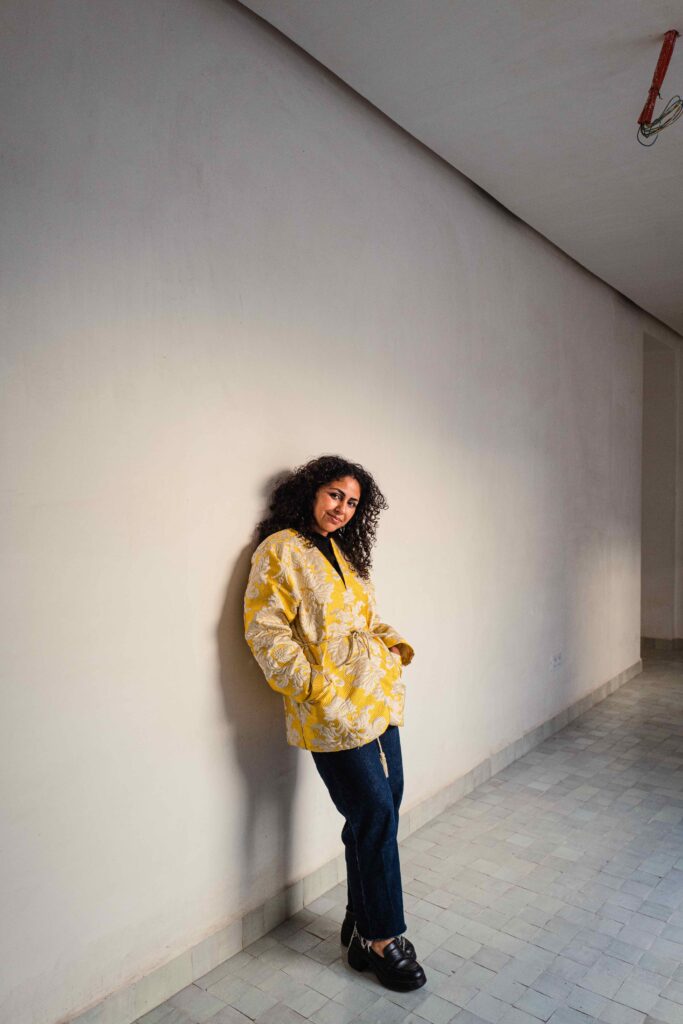
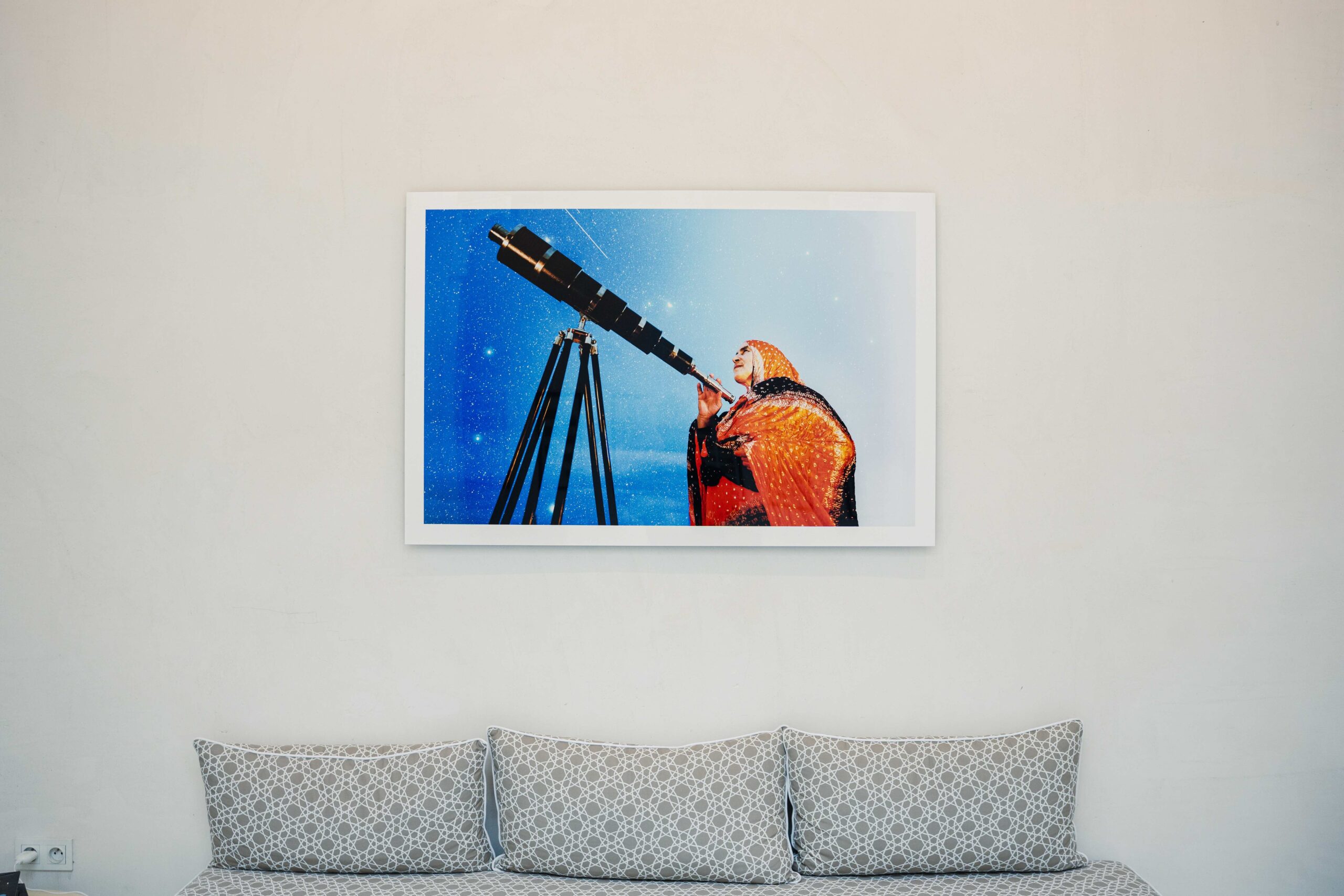
Mira: Women take centre stage in your images and when we visited your studio in Marrakech, you told us that the woman in Al-Astrulabiya is actually your grandmother and that she was the one to initiate this creative collaboration. That really stayed with me.
Sara: I’m always about representing Morocco, and I knew that to represent Morocco at 1-54, I had to have a Moroccan woman as the main subject. In my eyes, the true essence of Morocco is the Moroccan woman - specifically teta [grandma]. She represents a huge demographic of women who we don’t talk about, who we don’t see represented. I’m very lucky, as many women don’t like to be filmed or photographed, but with my grandmother - she’s very into that, she’s naturally very creative! I’ve never had to convince her to be involved. Even creating the works in Al-Astrulabiya, we did the shoot a million times, and every time she was ready to go, ready to stand on tables if needed - she was not afraid. She’s a special person and I’m glad I get to bring this figure forward to represent Morocco.

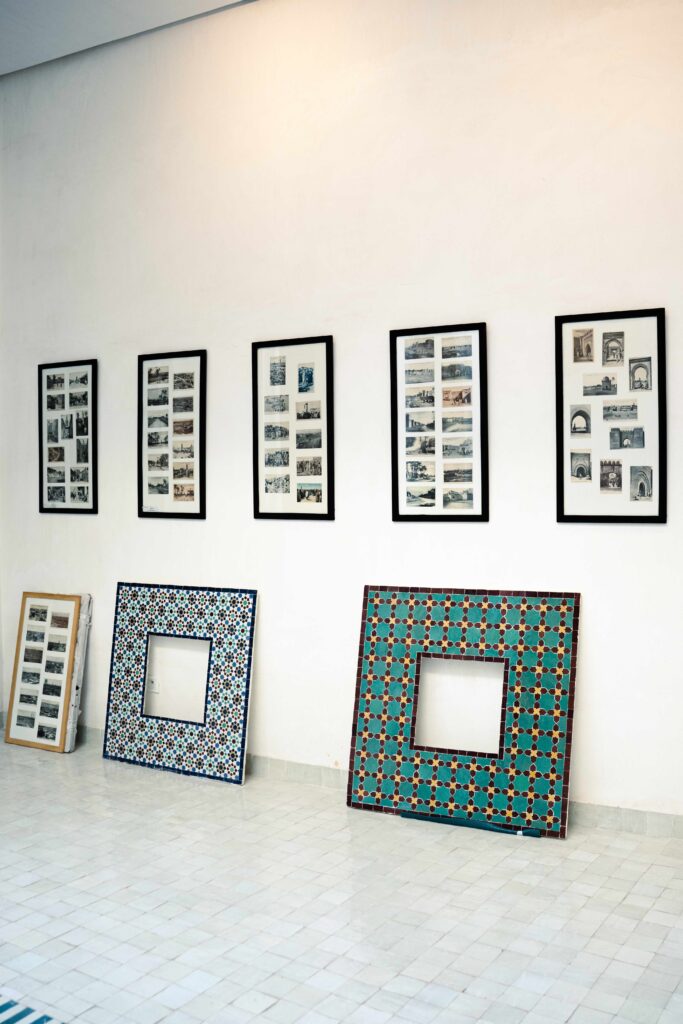
Mira: In your work, the frames are as significant as the works they hold. I'm a frame enthusiast myself, sometimes spending more on framing than the artwork itself, or collecting them in anticipation of finding the perfect work for it, so this aspect really stood out to me when I saw your work at La Mamounia. How do you understand the role of frames?
Sara: A year ago, I discovered this little collage frame I made for a photograph of my parents when I was seven. I didn’t think about them much, but it was always important in the back of my mind. When I was in America, going to museums and looking at art, the frames stood out to me as a missed opportunity. We use frames to restrict, to protect, to hold the artwork, but they can be storytelling tools.
During the COVID lockdown, I was in America - homesick and lost. It was snowing, and I was in the Midwest, in Amish Country, and I remember I had a picture my friend printed for me. I went outside and shoved the photo into the snow. It created this perfect frame. That was my first attempt to rethink frames. Al-Astrulabiya granted the perfect opportunity to continue; I could work with the artisans and develop a story through the details of the frames.

Mira: After spending nine years in the US, you returned home to Morocco. We have a tendency to anthropomorphise places; we can’t help but ascribe personalities to them, especially to our homelands. How does this manifest in the US and Morocco for you?
Sara: I lived in New York, LA, and Savannah, Georgia but spent a lot of time in the Midwest which to me is the true America. What I discovered was that in the Midwest, there were more similarities than differences to Morocco. The people there, the mindset, the way they care about their traditions, the central role of family, that time is still. Morocco is very slow-paced, and community is central. I liked finding those similarities because at the end of the day, it’s a wonderful thing that these two places that seem so different are connected.
1 Fathy (1973), ‘Constancy, Transposition and Change in the Arab City,’ in Madina to Metropolis, by (eds.) L. Carl Brown, Princeton, p 333.
GIDA © 2024

